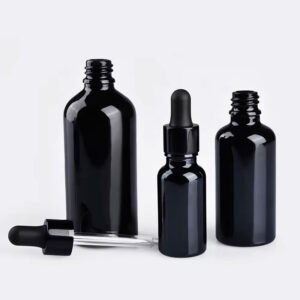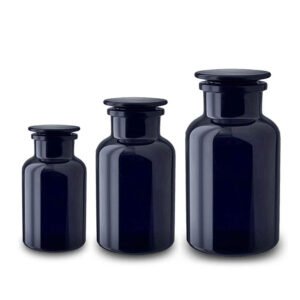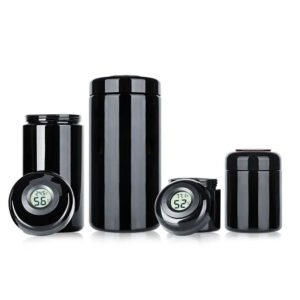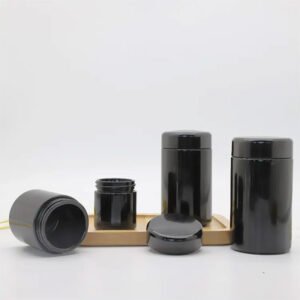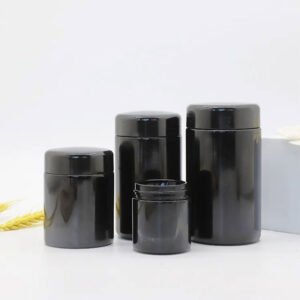Many famous beauty brands are known for their meticulous attention to providing high quality organic skincare products to their customers. With only natural, organic ingredients and no synthetic preservatives, proper packaging of these delicate compounds requires a great deal of care. Then, how to store & package organic skin care products for long-term preservation is a big challenge. This is also a major concern for the DIY enthusiasts who need to keep their DIY products for a shockingly long period of time.



Glass cosmetic containers are used to package a wide variety of cosmetic and natural skin care products, ranging from factory made to hand crafted. Makeup, creams, powders, body butters, moisturizers, and more can be stored in these glass containers. Typically, glass cosmetic containers come with airtight lids that protect the products from contaminants. Of course, that’s about as far as ordinary lidded cosmetic jars go. However, ultraviolet glass jars and bottles can do much more to keep cosmetics fresh, protect against degradation and extend shelf life without the need for preservatives.
History of using Violet Glass for Packaging
Since ancient times, people have tried to protect their most valuable products from the damaging effects of light. The early Egyptians, for example, preserved their precious substances in jars made of gold or purple glass. One of the most widely used materials is still glass, which has been around since time immemorial. However, most of the traditional colors used in glass packaging (clear, amber, blue, and green) allow visible light to pass through and therefore don’t provide adequate protection against the degradation processes caused by visible light.
The effect of sunlight is enormously important for growth. As a matter of fact, there is no life possible without light. The same light that made growth possible in the first place also speeds up the process of molecular decay. For instance, once plants are ready to be harvested, they must be used immediately or preserved effectively. If they are exposed to sunlight after having been harvested, decomposition can occur, drastically reducing the amount of bioenergy contained in the plant. The Fraunhofer Institute in Munich (Germany) believes that this process of degradation is due to radiation from visible light.
To verify this observation, a chemical analysis by gaschromatography of rosewater stored for two months under both violet and amber glass was performed at this institute. It was clearly shown that the amount of several important aromatic compounds was significantly reduced within a period of two months after the storage in the amber glass. No change was observed in the sample stored in the violet glass, suggesting a quality protection against decomposition by visible light.
Science Research of Violet Glass
Biophotonic research, the study of the absorption and emission of light particles by living cells, has shown that these wavelengths are very important for communication between living cells. Recent results in this field of science have also shown that the quality of food is not only dependent on the chemical composition, but also on the content of light energy and the potential information that is provided by the UVA and IR frequencies. This fundamental bio-information plays a decisive role in the control of all the processes that are vital for life. Biophotonic measurements show that foods, e.g. mature grains, plants and vegetables (fresh or dried), and any plant extracts (e.g. olive and flax oil) are perfect suppliers of light energy; a transfer that is closely related to the optical storage within the biological sample.
Nevertheless, high-quality food products lose their quality during storage and age prematurely. Biophotonic research on the quality of food, contained in different packaging materials, show that the quality of ordered biological energy of food stored in violet glass, is significantly higher than the counterparts kept in classical containers such as glass or plastic. In addition, it has been demonstrated that an optimal protection of the bio-information is obtained during the long-term storage in the violet glass.
The scientific research of biophotonics in the field of food quality control is under the direction of Professor Fritz-Albert Popp at the International Institute of Biophysics (IIB) in Hombroich near Düsseldorf (Germany). In the early eighties, he initiated this research at the University and Technology Center of Kaiserslautern, Germany.
Since 1988, Dr. Niggli has been in scientific collaboration with Professor Popp. In the middle of the nineties, he started a biophotonic research on the quality of food products stored in different types of packaging materials. Biological samples stored in violet glass jars preserve their quality bio-energy much better than those stored in classical packaging materials (e.g. amber glass, aluminum foil and plastic).
The evidence is in the chives
In the Miron Glass Sensory Test, you can experience the preservation effects of ultraviolet glass.
During these tests, chives were stored for three months inside three different types of glass jars: clear, amber and violet. The chives stored in the clear glass jars and the amber glass jars quickly became dry and gray. On the other hand, the chives stored in the violet glass jar retained their fragrance and rich green color.

The result of preserving green tea in clear & violet glass jars
After 6 months of storage, the green tea sample stored in the violet glass jar was still green and fresh, while the sample stored in the clear glass jar had turned dark. Also, the smell was much stronger and fresher for the green tea stored in the violet glass.
Comparing the results of green tea stored in UV, amber and clear glass jars.

3 Month Storage of Jujube in Clear, Amber and UV Glass
As shown in the picture, after 3 months of storage, the jujubes in the clear jar have become dry and dark, while those preserved in the purple jar are still red and fresh.

Violet Glass Containers for Long Term Preservation
Ultraviolet glass bottles appear black, but they’re actually violet when held against light. Ultraviolet glass absorbs almost all colors of the light spectrum, making it appear black. It is only permeable to the visible spectrum of violet light, hence its color. It effectively refracts all of the mid-range of the light spectrum.
Due this special combination, sensitive materials stored in violet-glass are highly protected against the processes of decomposition caused by light influences from the visible spectrum and gives it the added benefit of the positive effects that result from UVA, violet and IR frequencies.
Violet Glass vs. Black Glass vs
Violet glass does not allow light from the visible spectrum to pass (except for violet radiation), but is transparent in the infrared spectrum. Black glass doesn’t allow any visible light to pass through it, and is also transparent in the IR spectrum. The most important difference between these two types of glass is that black glass completely absorbs UVA and violet frequencies without allowing any transmission to occur, while violet glass allows these frequencies to be transmitted. These wavelengths are partially transmitted through the violet glass, giving it a unique quality: it is opaque to the visible spectrum of light from blue to red, but is open to the transmission of UVA, violet and IR frequencies.

How to Configure Dark Violet Glass Bottles and Optique Black Glass
Ultraviolet Glass Jars & Bottles
Ultraviolet glass jars have been available for over 20 years and have been used for the storage of a wide range of high quality products such as essential oils, flower essences, sunscreens, natural cosmetics, royal jelly, flax oils, massage oils and most recently olive oils. Many companies have discovered that UV glass bottles and jars add significant marketing value to premium quality products.
iMorePack Ultraviolet glass offers:
- Protection in the visible spectrum from blue to red
- Quality protection for long term storage
- Preservation of bio-energy
- 100% recyclable



